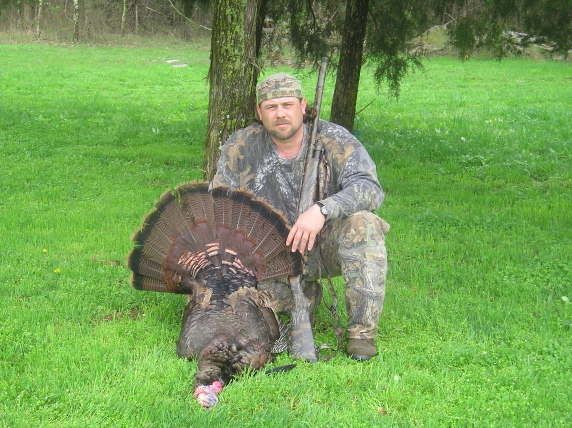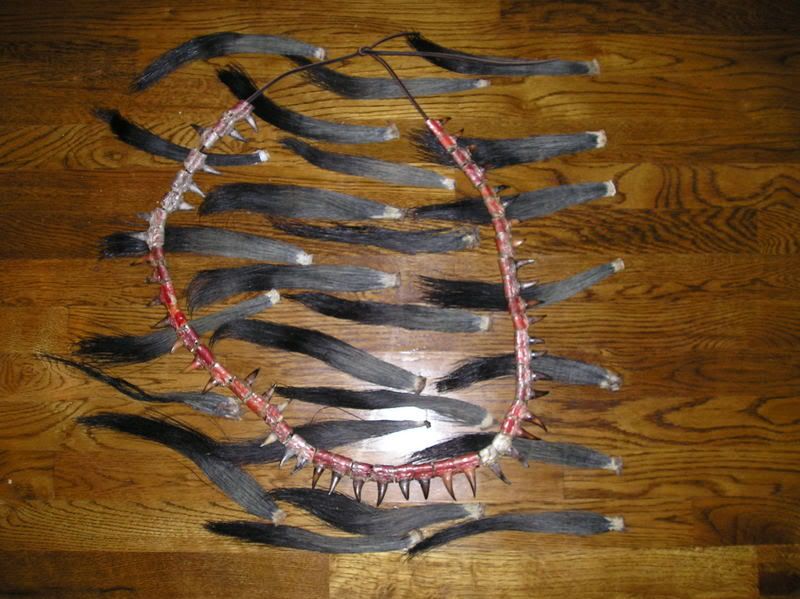Little sumthin I put together a number of yrs back. Might help a few new hunters in the turkey woods...
So you want to be a turkey hunter. Well congratulations on your decision to try your hand at the most frustrating and also one of the most rewarding endeavors known to the hunting world in my opinion. Although they are far from being the most intelligent creatures to walk in the wilderness, do not confuse intelligence with the ability to survive. The Eastern gobbler has reduced a many of grown men to tears, humbled even the most seasoned outdoorsmen time and time again. The challenge and beauty of it all is what drives me yr after yr in the spring turkey woods. The ultimate game of cat and mouse. Lets do it.
Good turkey habitat is a mix of hardwoods and fields, vertical topography seems to be preferred by the birds. A good water source is a must for quality turkey ground. With vision that would rival even the most prolific predators of the sky the wild turkey depends on it's vision more than anything else to survive. Thickets are not tolerated for this reason and will be skirted by the birds. They also have excellent hearing and can narrow a run of yelps down to mere feet from distances of hundreds of yds.
Scouting the birds consist of looking for scratchings, glassing fields, droppings, dusting sites, and roosting sites. As the birds move and feed thru the forest floor they will leave a V shape in the leaves thereby exposing their direction of travel. Unlike whitetail, a trained eye can tell the difference between the droppings of hens and gobblers.The droppings of a gobbler will be shaped like a J. Finding good dusting sites can pay big dividends during the spring turkey season. As the Spring temps begin to rise, the birds will use these more often because of parasites. Gobblers know where these preferred dusting sites are, and will monitor them looking for hens, an excellent spot to decoy the ole wary toms. Finding your particular hunting ground's preferred roosting sites can be done by simply being in the woods at first and last light. The birds are extremely vocal in the mornings before and during flydown time. The gobblers will respond to a number of different calls exposing their location. An owl hooter, crow call, coyote call, pileated woodpecker are some of the most common. The owl hooter has worked extremely well for me over the yrs. The hens will cackle during flydown, this is an excellent but extremely hard call to master,good luck.
Setting up on birds, the setup is everything in enabling you to close the deal. There are many facets to be considered when determining your final set up on a gobbling turkey. First, you simply have to know the terrain of your hunting ground. Creeks, thickets, and fences can hang a bird up just out of gun range. Also when having to move or circle a particular gobbling tom stealth is key. You have to use your knowledge of the terrain as to not expose yourself visually to the birds incredible eyesight. Try to find the largest tree in the immediate area when a nearby gobbler sounds off. Good camoflage from head to toe is extremely important. As the bird approaches do not move, wait for the birds head to go behind a tree or other obstacle before shifting or moving your weapon. Alot of birds come in the last 100 yds or so silently, so don't give up just because the bird has stopped responding, be patient.
Classic hunt, the classic hunt is when a gobbling turkey is located on the roost. The hunter moves in as close as possible but not within eyeshot of the bird. The hunter then sets up, calls to the bird, the bird pitches down and walks straight into the gun barrel. When it happens it is a wonderous event, might lead a beginning turkey hunter to believe the birds are especially easy to take. But be forwarned, more times than not it doesn't quite go this way. There are things a hunter can do to up his odds, first try to set up between where the bird is and where you believe the bird is wanting to go. Gobblers normally have strutting zones, he will more times than not disregard your calls if he wants to head in the other direction to gather his hens. I have also found that most birds will not work into the sun at first light, the blinding sun hampers their most effective sense of survival, their vision.
Calling to birds, different types of calls and calling techniques are the bread and butter of killing wary old gobblers. Don't get me wrong, a simple box call and a series of yelps might do the trick. But to be consistently successful in the turkey woods you have to become versatile with a number of different calls. The box call is probably the easiest to master, then the slate, and last but not least the mouth diaphram. By all means, if you sound like a dying dog with a mouth diaphram, leave it at home. Some even experienced hunters I've encountered just simply can't blow a mouth call. Stick with the calls that sound authentic. Most quality box calls make incredible sounding yelps, clucks, and cutting sequences. The slate is fairly easy to master and also makes exceptional yelps, clucks, cuts, and also the purs along with the fighting purs. I cannot tell you what a particular gobbler wants to hear. But with experience and a good ear a hunter will let the bird tell him what he prefers. Some birds want to be hammered with hard cuts, others won't tolerate it at all. If the bird is responding to a specific call, and moving closer doublegobbling the whole way, then continue to give it to him. One of the biggest mistakes made by turkey hunters is simply calling to loud and to often. A good rule of thumb is start off soft, work thru a series of calls, soft clucks, yelps, purs, then if he seems to loose interest hit him with some hard cuts. Hard cutting has been my most effective way of locating and killing hot gobblers. Be aware, pressured birds are different creatures, if you are hunting birds which have been pressured hard and call shy, soft clucks, contempt and feeding purs and simply scratching in the leaves or flapping a turkey wing may be your best bet. Also, if a bird is within eyeshot and moving in to your position, shut up and let him come.
Decoying birds, decoys are one of the most deadly assets a turkey hunter can use. A jake with a couple of hens in a field encompassing a mature gobblers strutting area is hardly tolerable by the ole tom. He will come a running more times than not and go directly to the jake. Strongly consider the visual aspect of the area before placing your decoys. To many hunters place their decoys in a way which amazes me, it almost seems they are trying to hide the decoys. Find a knob or high point that will be seen by any gobbler standing right inside the timber and watching a field or opening. Warning, some birds that have encountered dekes and been shot at in the past will keep their distance and strut and gobble, after the passing of time and not seeing movement or any reaction from the dekes, I've seen gobblers turn and practically run the other direction. These birds can almost be unkillable without a long and well planned stalk and ambush.
Henned up gobblers, tough hunting for sure, your best bet is to first try to call the hens. Hard clucks and cuts will sometimes fire up a hen and bring her to you with the gobbler in tow. If this can't be accomplished you must think of the terrain and move to a locaion with options of stealthy movement. In other words move to a central location which gives you the most options of movement, allowing you to circle the flock. If this scenario isn't feasible, you're better off moving on to another location and trying to find a lonely gobbler. Don't push your luck, educating birds is an extremely bad idea.
Shot placement, the shot should be zeroed in at the base of the head where the head and neck meet. Turkeys are extremely tough creatures and if you don't break him down a bird will get gone quick without leaving a blood trail whatsoever. You simply must know your weapon. Pattern your gun before the season with different loads at specifics ranges. A good rule of thumb is you need approximatly 13 hits in the head and neck region to break the animal down. To many hunters believe they can kill birds at ranges exceding 50 yds with the new magnum high velocity loads and expensive aftermarket chokes. Know your effective killing range. One more thing, when you shoot a gobbler, get to him quick. I've seen alot of birds roll and appear to be down only to get up and take to the air and gone.
A few other points to ponder, turkeys stay on the ground all day. Patience and persistence has killed more gobblers than anything. It's definitely not strictly a morning or evening deal. Never wear an article of clothing with the colors red, white, or blue. These are the colors of the gobblers head, and many hunters are shot each season in the turkey woods. Know your target. Good quality optics can make or break a hunt when trying to move in on a wary old tom. I'm not going to down a fellar hunter for shooting jakes, but if you want gobbling turkeys you must give em a pass. I personally don't shoot em.
Good luck guys and gals.



